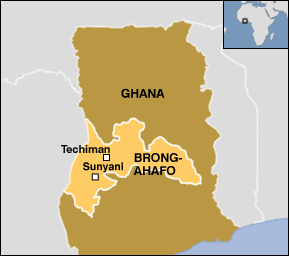HopE Ghana’s Area of Operation

Background, Political and Administrative Structure
The Brong Ahafo Region was created on April 4, 1959 (by the Brong Ahafo Region Act NO.18 of 1958) from the then Ashanti Region and the previous Northern Regional areas of Prang and Yeji. The region has 27 administrative districts- 8 municipal and 19 ordinary districts with Sunyani as the regional capital. The region covers an area of 39,557 square kilometers and is the second largest region in Ghana (16.6%). It shares borders to the north with the Northern Region; Ashanti and Western Regions to the south; the Volta Region to the East and La Cote D’Ivoire to the West. The Central point of Ghana’s landmass is located in Kintampo in Brong Ahafo Region.
Population, Ethnicity and Religion
Brong Ahafo Region has a population of about 2, 310, 983 (Ghana Statistical Service & 2010 Census) and accounts for 9.4% of Ghana’s total population. Child dependency ratio is 73.2% and the predominant ethnic group is Akan. Meanwhile, other ethnic groups such as the Guans, Gurmas, Ewes, Mole-Dagbon, Grusi, Mande-Busanga. Ethnic groups from the three northern regions of Upper West, Upper East and Northern Regions are slightly more than a quarter of the population of Brong Ahafo Region. A little over two-thirds are Christians. Islam and Traditional religions follow with very insignificant numbers being adherents of Buddhism and Hinduism. One in three Christians is a Pentecostal or Charismatic with Catholics making up one-fifth of the region’s population.
Education
According to the 2010 Population and Housing Census, only five districts in Brong Ahafo have more than 5% of households owning laptops and/or desktop computers. Even though the literacy level of persons 11years and older in the region is about 70% according to the 2010 population and housing census, and 51.7% has attained basic education- Primary, 26.2%; Junior High School, 18.3% and Middle School, 7.2% – a little over 5% of the population of Brong Ahafo has higher education beyond the secondary level to a first degree with one in a thousand (1 in 1000) attaining post-graduate education. The situation is even quite alarming when one considers the information on the official Ghana Government website which claims that the proportion of the regional population who are currently at post-secondary level is the lowest in Ghana, that is, 1.3%. (http://www.ghana.gov.gh/index.php/about-ghana/regions/brong-ahafo). This includes those in Colleges of Education (Training Colleges) and Nursing Colleges. It is vital to state that over two-fifths (42%) of the population 6 years and older have never been to school before (Ghana.gov.gh). And while 3.4% of males have never attended school, about 30.7% of females have never attended school (2010 Census). Apart from the basic level (Primary, Junior High and Middle School) where females lead males by 40.6% to 36%, males have higher levels of education than females at all levels of education. In the national literacy table, Brong Ahafo is 7th out of the 10 regions with almost 70% literacy rate, beating only the three northern regions (2010 Census) but has the lowest percentage of population beyond secondary education (Ghana.gov.gh).
Occupation
According to the 2010 Census, majority of persons 15 years and older, the economically active population, in rural Brong Ahafo (78%) is in agriculture, forestry and fisheries industry, all of which are mainly subsistence agriculture and related work forms. Only 37.2% of urban dwellers are in this sector. The next most important occupation is t service and sales (14.1%), followed by crafts and related trade workers (10%). Six employed persons in ten (6 in 10) are in the agricultural, forestry and fishing industry, seven in ten (7 in 10) employed persons in rural areas and three in ten (3 in 10) in urban areas in the Brong Ahafo Region.
Links:
